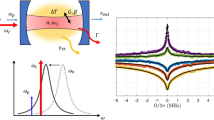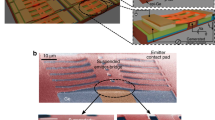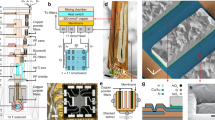Abstract
Photonic cooling of matter has enabled both access to unexplored states of matter, such as Bose–Einstein condensates, and novel approaches to solid-state refrigeration1,2,3. Critical to these photonic cooling approaches is the use of low-entropy coherent radiation from lasers, which makes the cooling process thermodynamically feasible4,5,6. Recent theoretical work7,8,9 has suggested that photonic solid-state cooling may be accomplished by tuning the chemical potential of photons without using coherent laser radiation, but such cooling has not been experimentally realized. Here we report an experimental demonstration of photonic cooling without laser light using a custom-fabricated nanocalorimetric device and a photodiode. We show that when they are in each other’s near-field—that is, when the size of the vacuum gap between the planar surfaces of the calorimetric device and a reverse-biased photodiode is reduced to tens of nanometres—solid-state cooling of the calorimetric device can be accomplished via a combination of photon tunnelling, which enhances the transport of photons across nanoscale gaps, and suppression of photon emission from the photodiode due to a change in the chemical potential of the photons under an applied reverse bias. This demonstration of active nanophotonic cooling—without the use of coherent laser radiation—lays the experimental foundation for systematic exploration of nanoscale photonics and optoelectronics for solid-state refrigeration and on-chip device cooling.
This is a preview of subscription content, access via your institution
Access options
Access Nature and 54 other Nature Portfolio journals
Get Nature+, our best-value online-access subscription
$29.99 / 30 days
cancel any time
Subscribe to this journal
Receive 51 print issues and online access
$199.00 per year
only $3.90 per issue
Buy this article
- Purchase on Springer Link
- Instant access to full article PDF
Prices may be subject to local taxes which are calculated during checkout




Similar content being viewed by others
Data availability
The data that support the findings of this study are available from the corresponding authors on reasonable request.
References
Chu, S. The manipulation of neutral particles. Rev. Mod. Phys. 70, 685–706 (1998).
Epstein, R. I., Buchwald, M. I., Edwards, B. C., Gosnell, T. R. & Mungan, C. E. Observation of laser-induced fluorescent cooling of a solid. Nature 377, 500–503 (1995).
Zhang, J., Li, D. H., Chen, R. J. & Xiong, Q. H. Laser cooling of a semiconductor by 40 kelvin. Nature 493, 504–508 (2013).
Landau, L. On the thermodynamics of photoluminescence. J. Phys. 10, 503–506 (1946).
Mungan, C. E. Radiation thermodynamics with applications to lasing and fluorescent cooling. Am. J. Phys. 73, 315–322 (2005).
Ruan, X. L., Rand, S. C. & Kaviany, M. Entropy and efficiency in laser cooling of solids. Phys. Rev. B 75, 214304 (2007).
Chen, K., Santhanam, P. & Fan, S. Near-field enhanced negative luminescent refrigeration. Phys. Rev. Appl. 6, 024014 (2016).
Chen, K., Santhanam, P., Sandhu, S., Zhu, L. & Fan, S. Heat-flux control and solid-state cooling by regulating chemical potential of photons in near-field electromagnetic heat transfer. Phys. Rev. B 91, 134301 (2015).
Chen, K. F., Xiao, T. Y. P., Santhanam, P., Yablonovitch, E. & Fan, S. H. High-performance near-field electroluminescent refrigeration device consisting of a GaAs light emitting diode and a Si photovoltaic cell. J. Appl. Phys. 122, 143104 (2017).
Pathria, R. K. & Beale, P. D. Statistical Mechanics 3rd edn (Academic, 2011).
Henry, C. & Kazarinov, R. Quantum noise in photonics. Rev. Mod. Phys. 68, 801–853 (1996).
Wurfel, P. The chemical potential of radiation. J. Phys. C 15, 3967–3985 (1982).
Berdahl, P. Radiant refrigeration by semiconductor diodes. J. Appl. Phys. 58, 1369–1374 (1985).
Song, B. et al. Radiative heat conductances between dielectric and metallic parallel plates with nanoscale gaps. Nat. Nanotechnol. 11, 509–514 (2016).
Fiorino, A. et al. Giant enhancement in radiative heat transfer in sub-30 nm gaps of plane parallel surfaces. Nano Lett. 18, 3711–3715 (2018).
Bernardi, M. P., Milovich, D. & Francoeur, M. Radiative heat transfer exceeding the blackbody limit between macroscale planar surfaces separated by a nanosize vacuum gap. Nat. Commun. 7, 12900 (2016).
St-Gelais, R., Zhu, L. X., Fan, S. H. & Lipson, M. Near-field radiative heat transfer between parallel structures in the deep subwavelength regime. Nat. Nanotechnol. 11, 515–519 (2016).
Rousseau, E. et al. Radiative heat transfer at the nanoscale. Nat. Photon. 3, 514 (2009).
Shen, S., Narayanaswamy, A. & Chen, G. Surface phonon polaritons mediated energy transfer between nanoscale gaps. Nano Lett. 9, 2909–2913 (2009).
Fiorino, A. et al. Nanogap near-field thermophotovoltaics. Nat. Nanotechnol. 13, 806–811 (2018).
Ganjeh, Y. et al. A platform to parallelize planar surfaces and control their spatial separation with nanometer resolution. Rev. Sci. Instrum. 83, 105101 (2012).
Sadat, S., Meyhofer, E. & Reddy, P. Resistance thermometry-based picowatt-resolution heat-flow calorimeter. Appl. Phys. Lett. 102, 163110 (2013).
Song, B. et al. Enhancement of near-field radiative heat transfer using polar dielectric thin films. Nat. Nanotechnol. 10, 253–258 (2015).
Sadat, S., Meyhofer, E. & Reddy, P. High resolution resistive thermometry for micro/nanoscale measurements. Rev. Sci. Instrum. 83, 084902 (2012).
Kim, K. et al. Radiative heat transfer in the extreme near field. Nature 528, 387–391 (2015).
Cui, L. et al. Study of radiative heat transfer in Ångström- and nanometre-sized gaps. Nat. Commun. 8, 14479 (2017).
Il’inskaya, N. D. et al. InAs0.7Sb0.3 bulk photodiodes operating at thermoelectric-cooler temperatures. Phys. Status Solidi A 215, 1700694 (2018).
Lee, W. et al. Heat dissipation in atomic-scale junctions. Nature 498, 209–212 (2013).
Xiao, T. P., Chen, K., Santhanam, P., Fan, S. & Yablonovitch, E. Electroluminescent refrigeration by ultra-efficient GaAs light-emitting diodes. J. Appl. Phys. 123, 173104 (2018).
Atabaki, A. H. et al. Integrating photonics with silicon nanoelectronics for the next generation of systems on a chip. Nature 556, 349–354 (2018).
Santhanam, P., Gray, D. J. & Ram, R. J. Thermoelectrically pumped light-emitting diodes operating above unity efficiency. Phys. Rev. Lett. 108, 097403 (2012).
Sadat, S. et al. Room temperature picowatt-resolution calorimetry. Appl. Phys. Lett. 99, 043106 (2011).
Whittaker, D. M. & Culshaw, I. S. Scattering-matrix treatment of patterned multilayer photonic structures. Phys. Rev. B 60, 2610–2618 (1999).
Rytov, S., Kravtsov, Y. & Tatarskii, V. Principles of Statistical Radiophysics Vol. 3 (Springer, Berlin, 1989).
Otey, C. R., Zhu, L., Sandhu, S. & Fan, S. Fluctuational electrodynamics calculations of near-field heat transfer in non-planar geometries: A brief overview. J. Quant. Spectrosc. Radiat. Transfer 132, 3–11 (2014).
Zhu, L. & Fan, S. Near-complete violation of detailed balance in thermal radiation. Phys. Rev. B 90, 220301 (2014).
Fu, C. J. & Zhang, Z. M. Nanoscale radiation heat transfer for silicon at different doping levels. Int. J. Heat Mass Transfer 49, 1703–1718 (2006).
Basu, S., Lee, B. J. & Zhang, Z. M. Near-field radiation calculated with an improved dielectric function model for doped silicon. J. Heat Transfer 132, 023302 (2010).
Acknowledgements
E.M. and P.R. acknowledge support from DOE-BES award no. DE-SC0004871 (Scanning Probe Development and Analysis) and from the Army Research Office award no. FO42860 (Instrumentation and Nanopositioning Tools). We acknowledge the Lurie Nanofabrication Facility for facilitating the fabrication of devices.
Reviewer information
Nature thanks P. Bharadwaj, Y. De Wilde and J. Saenz for their contribution to the peer review of this work.
Author information
Authors and Affiliations
Contributions
E.M. and P.R. conceived the work. L.Z. and A.F. performed the experiments. L.Z. performed the calculations and polished the photodiodes. D.T. and R.M. fabricated the calorimeter devices. The manuscript was written by L.Z., E.M. and P.R. with comments and inputs from all authors.
Corresponding authors
Ethics declarations
Competing interests
The authors declare no competing interests.
Additional information
Publisher’s note: Springer Nature remains neutral with regard to jurisdictional claims in published maps and institutional affiliations.
Extended data figures and tables
Extended Data Fig. 1 Fabrication of the calorimeter.
a, Step 1: a double-bonded silicon-on-insulator wafer from which the calorimeter is fabricated. Step 2: doping at the surface via phosphorus diffusion. Step 3: removing the phosphosilicate glass (PSG) layer that is formed during doping using a buffered hydrofluoric acid solution. Step 4: RIE to form a mesa feature. Step 5: patterning of the platinum serpentine thermometer. Step 6: RIE to form the footprint of the suspended device. Step 7: etching the silicon handle wafer using deep RIE to suspend the device. b, A representative scanning electron microscope image of a fabricated calorimeter device.
Extended Data Fig. 2 Characterization of the frequency response and the thermal conductance of the calorimeter, and the surface roughness for the calorimeter mesa and the photodiode.
a, A schematic of the measurement approach employed for obtaining the data shown in b and c. b, Frequency response of calorimeter, showing the normalized temperature increase of the calorimeter as a function of the frequency of heating. c, Measured relation between the power input into the suspended region of the calorimeter and the temperature increase. The black line represents a linear fit to the experimental data. d, AFM image of the calorimeter mesa, showing particles for which the largest height is around 55 nm. e, AFM image of the photodiode after polishing and cleaning, featuring a peak-to-peak roughness of around 25 nm.
Extended Data Fig. 3 Averaging scheme for measuring the cooling power.
a, Schematic depiction of the voltage bias applied to the diode. The diode is periodically biased for a duration of 4 s at a periodicity of TP = 8 s. b, Schematic depiction of the lock-in voltage output, Vf, (measured using an SR830 lock-in amplifier, Stanford Research Systems) across the platinum serpentine resistor of the calorimeter in response to a high-frequency (f = 2,534 Hz) sinusoidal current of amplitude If.
Extended Data Fig. 4 Schematic for measuring the radiative conductance GNFRHT.
a, Schematic of the set-up for measuring radiative conductance. The emitting area of the photodiode is located below the n-InAs layer. b, Effective thermal resistance network illustrating the major heat transfer pathways. The calorimeter has a power input (Qcal) due to a current supplied to the platinum resistor. The calorimeter has two major heat dissipation pathways, including heat conduction through the beams with thermal conductance Gbeams, and radiative heat exchange with the diode via a radiative conductance GNFRHT. c, d, Simultaneously recorded displacement and calorimeter temperature change (∆Tcal) during a GNFRHT measurement.
Supplementary information
Supplementary Information
This file contains Supplementary Text and Data, Supplementary Figures 1-12 and Supplementary References.
Rights and permissions
About this article
Cite this article
Zhu, L., Fiorino, A., Thompson, D. et al. Near-field photonic cooling through control of the chemical potential of photons. Nature 566, 239–244 (2019). https://doi.org/10.1038/s41586-019-0918-8
Received:
Accepted:
Published:
Issue Date:
DOI: https://doi.org/10.1038/s41586-019-0918-8
This article is cited by
-
Corner- and edge-mode enhancement of near-field radiative heat transfer
Nature (2024)
-
All electromagnetic scattering bodies are matrix-valued oscillators
Nature Communications (2023)
-
Near-field thermophotovoltaics for efficient heat to electricity conversion at high power density
Nature Communications (2021)
-
Transforming heat transfer with thermal metamaterials and devices
Nature Reviews Materials (2021)
-
High-performance photonic transformers for DC voltage conversion
Nature Communications (2021)
Comments
By submitting a comment you agree to abide by our Terms and Community Guidelines. If you find something abusive or that does not comply with our terms or guidelines please flag it as inappropriate.



